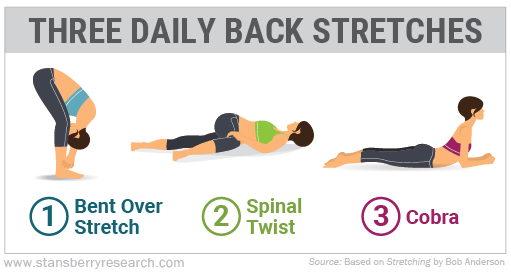It happens too often: Searing, thudding pain stops you in your tracks. Sometimes it's when you're bending over or trying to lift something off the ground. You can't play with your grandkids or even walk up your stairs without discomfort.
For just about all of you reading this, you know all too well the agony of back pain. Back pain affects about 80% of Americans at some point in their lives.
In fact, back pain is the third-most common reason for doctor appointments (after skin diseases and joint problems).
And lower-back pain is a chief complaint. About 34% of folks 65 and older complain of lower-back pain, which can interfere with daily chores, exercise, and sleep. What's more, about 90% of all back-pain cases never have an identified cause.
Many doctors let folks opt for opioid drugs. Opioids are synthetic drugs designed to attach to our "opioid receptors" to interfere with pain signals. The big problem with these drugs is that our bodies quickly build up a tolerance – making them useless. And that leads to increasing dosing, abuse, and even addiction.
But opioids are no more effective than nonopioid pain medications. A recent study compared opioids directly with medications like acetaminophen (Tylenol), naproxen (Aleve), and lidocaine (Lidoderm). After 12 months, the nonopioid group had less severe pain than the opioid group. Do what I do and don't use opioids for pain, ever.
In my recent issue of Retirement Millionaire, I outlined four alternative ways to combat back pain. To get you started, I'm sharing one of them below...
Doc's tip: Stretch daily. One of the best books I've read is Stretching, by Bob Anderson. It's been 30 years since its first edition, but the instructions are timeless. (You can purchase a copy right here.)
Stretching helps loosen our muscles and prevent strains and sprains. It's a great way to gently relieve muscle pain and prepare you for more strenuous exercises.
Some of my favorite stretches for back pain include:
Bent-over stretch: Bend your knees about an inch and slowly bend forward. If you can, touch your toes. If not, grab onto a chair or a table to help steady you. Hold the position for 15 seconds, then slowly stand back up.
Spinal twist: This is great for your lower back and hips. Lie on the floor and slowly bring one knee up to a bent position. Then cross it over your body – so your left knee would twist to the right and vice versa. Keep your back flat and hold for five to 15 seconds. To increase the stretch, turn your head to look in the opposite direction of your bent knee.
Cobra: I love this yoga position. Resting on your belly, keep your feet out with the tops resting on the floor. Place your elbows beneath your shoulders and gently push your shoulders and chest up, keeping your hips on the floor. Hold this position for about 10 seconds. This is actually the "partial cobra." Once you can do this comfortably, try moving on to the "full cobra." That's when you extend your arms to arch your back even more... It's next to impossible to keep back pain if you do this regularly enough.
Adding a good stretching routing will help alleviate minor-to-moderate back pain. And for further relief, I outlined three other tips for you to try.
If you don't subscribe to Retirement Millionaire, you can get started here. Current subscribers can access the issue here.
[optin_form id="73"]
What We're Reading...
- Something different: Why is writing a dress code so hard?
Here's to our health, wealth, and a great retirement,
Dr. David Eifrig and the Health & Wealth Bulletin Research Team
April 10, 2018

